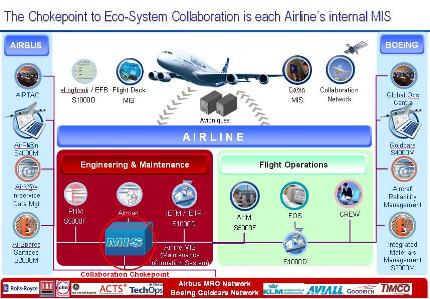As airlines across the globe move to equip their aircraft with passenger connectivity systems, the discussion is heating up about how to achieve operational gains from these higher-bandwidth pipes.
For maintenance departments, the promise of being able to pull large quantities of information from aircraft in real-time to enhance diagnostics and prognostics is attractive.
"Before, crew may have notified the ground that there was a broken seat on the aircraft via character-specific ACARS," notes in-flight connectivity consultant Michael Planey. "Now they can provide a more descriptive problem statement in the log and it's done less expensively as part of a batch of all kinds of other transmissions going to the ground. The maintenance organisation can meet that aircraft with parts or at least be prepared so that a repair or replacement can be accomplished as quickly as possible."
The problem preventing such efficiencies from being realised on a grand scale, says Michael Denis of professional services firm Aviation Wikinomics, is that there is no connection between condition-based monitoring and supply chain optimisation tools.
"Nobody has connected those tools. Airlines are paying millions, even billions, for modern/technologically advanced aircraft only to dump the information on the floor and do nothing with it," he says. "The choke point to creating true eco-system collaboration is in airlines' maintenance information systems (MIS)."
 |
|---|
Denis points out that most airlines and third-party maintenance, repair and overhaul providers are running on 1980s-generation technology. "You can't connect the aircraft to their MIS and even if you could, these systems couldn't do anything with the data anyway."
Addressing this choke point, however, will equate to an improvement in technical dispatch rates, "and improved aircraft availability means higher revenues", notes Denis.
For airlines that have MROs as part of their operation, the advantages promise to be even greater. "In those instances, the airline is also cashing the check on maintenance labour and maintenance material, and can increase its number of MRO customers," he says.
But how does the industry address the MIS choke point? "The complexity of this is admittedly staggering," says Denis. "Everybody has been working on little bits and pieces of the global information net. However, to date, the only guys who have a real financial incentive to do this have been the engine guys because to profitably sell power-by-the-hour agreements requires engine health monitoring bundled into the sale or lease and support package."
On the OEM side, Boeing has a well-defined business model in its GoldCare programme for 787 customers and the airframer is building the tools to enable eco-system collaboration, but it hasn't sold the vision yet, notes Denis.
Large airline-affiliated MROs have progressed in building decision support networks between suppliers, partners and their customers. But most airlines cannot afford to overhaul their MIS.
This is where aircraft lessors may play an important role, says Denis, as they "have significant influence on these carriers and can spearhead an industry standard collaborative solution".
Ray Valeika, former Delta Air Lines senior vice-president, technical operations, who currently works as an independent consultant and member of the board at leasing giant AerCap, says: "From a lessor's standpoint, it is important to have more of a standardised MIS. Then it becomes less costly to transfer an aircraft from one operator to another."
The manufacturers also have an interest in a more standardised process, says Valeika. "There is some movement on their part to do this with new-design aircraft programmes [such as the Airbus A350, Boeing 787 and Bombardier CSeries], but that doesn't translate to the thousands of pieces of equipment now operating. So I think it's going to become a financial play: first on the part of the OEMs to create incentives for more common platforms and also on the part of the leasing companies that own the airplanes, to make them more transferable and thus reduce costs to the operators."
Source: Flight International























